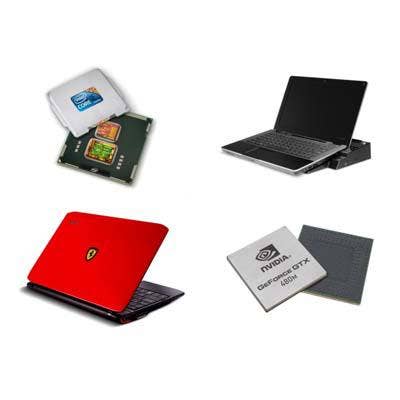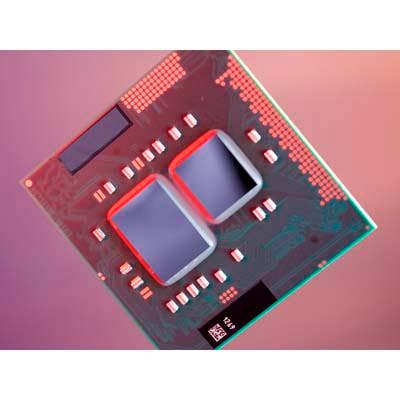The Best Mobile Chips Of 2010 (So Far)

Going Mobile
Tethered to the relentless march of Moore’s Law, computer manufacturers keep churning out new PC hardware -- and the first half of 2010 provided gearheads with a smorgasbord of CPUs, GPUs and other components to drool over. We’ve already looked at top desktop chips from the first half, and now it’s time to review the best mobile PC processors and graphics.
How did we pick the winners? Through a combination of culling through best-selling product on e-tail sites like Newegg.com and TigerDirect.com, poring over our own CRN Test Center’s first-half reviews, and surveying the custom system builders whose business is identifying the very best computer parts for the best prices.

High-End Mobile CPU
The Core i7-940XM Extreme Edition from Intel runs a bit hot for a notebook processor at 55 watts, but this Clarkfield-class part promises to rewrite the rules for enthusiast-oriented laptops. How about a 2.13-GHz CPU that jacks up the clock to 3.33GHz when Intel Turbo Boost is engaged? Or four cores, eight threads, 8MB of L3 cache and 1333MHz DDR3 memory -- all in a mobile form factor? Wow.
Intel is listing the Core i7-940XM on its current price list and the product is shipping to OEM partners, but don’t expect to see systems until the third quarter.
Release date: Q2, 2010
Price: $1,098

Mainstream Mobile CPU
One of the most popular mobile processors released as part of Intel’s early January onslaught of new products, the Core i5-520M is a very nice CPU from Intel at a price that won’t break the bank. A linchpin of this year’s 32-nanometer process technology transition, the 35W Core i5-520M has a 2.4-GHz clock that can be Turbo Boosted, two processor cores and 3 MB of L3 cache.
Also competitive in this broad category are Intel’s latest Core i3 mobile processors, as well as the always attractively priced options from AMD, which include new Turion II, Athlon II and Phenom II notebook CPUs.
Launch date: Jan. 7, 2010
Price: $225

Value Mobile CPU
Intel’s dual-core, 35W Celeron P4500 offers considerable value -- a 1.86-GHz processor clock, 2MB of L2 cache and 32-nm process technology -- delivering similar performance to certain older Core 2 Duo parts but for a lower price.
The key to the Celeron P4500 is the transition to the Nehalem and Arrandale architecture updates. With this entry-level notebook chip, Intel is integrating the memory controller and integrated graphics into the CPU package. The result – the P4500 is a decent benchmarking processor despite its so-so clock and lack of Turbo Boost and Hyper-Threading technology.
Launch date: March 26, 2010
Price: $86

Ultra-Thin Notebook CPU
Apple may have kicked off the ultra-thin notebook craze with the Intel-based MacBook Air back in early 2008, but AMD has spent the intervening years fine-tuning a hardware platform designed specifically for low-power, lightweight, ultra-sleek machines like the pictured notebook from Acer.
That work culminated in AMD’s introduction of its third-generation ultra-thin notebook platform, Nile, in May. Based around the AMD RS880 series chipset and Mobility Radeon HD 4200 series graphics, Nile can utilize either a single-core chip, or a dual-core powerhouse like the 1.7GHz, 15W Turion II K665 -- our pick for best new ultra-thin CPU in the first half of 2010.
Launch date: May 12, 2010
Price: OEM pricing

Netbook CPU
Some may call the Atom N470 a placeholder for the upcoming Atom N550, Intel’s first dual-core netbook chip scheduled for a third-quarter release. But as placeholders go, this 45-nm, Pineview-class ultra low-voltage part ain’t too shabby. The Atom N470 is a 1.83-GHz, 6.5W System-on-Chip part that integrates the memory controller and Intel’s GMA 3150 graphics onto the processor die.
Launch date: March 1, 2010
Price: $75

Tablet CPU
The first thing you need to know about the single-core, ARM-based Apple A4 processor is that it’s sold a heck of a lot in the three months or so since it arrived in the iPad tablet from the Cupertino, Calif.-based idea factory. More than three million units, to be precise -- and that’s just the iPad sales. An Apple-designed A4 also powers the new Apple iPhone 4, which was moving to the tune of about 1.2 million units shipped in just three days following its release.
The other thing you need to know is that it’s pretty difficult to figure out what exactly makes the A4 tick. Apple isn’t saying much and neither is Samsung, which manufactures the things and puts them in its own Wave devices. What we can gather is that the A4 is a package on package (PoP) system-on-a-chip (SoC) with a 1-GHz clock that includes both a Cortex-A8 CPU core and a 45-nm PowerVR SGX 535 GPU. However you slice it, 4.2 million units shipped in just a few months is pretty impressive (forgive us if we assume that Samsung Wave sales haven’t added much to the total).
Launch date: April 3, 2010 (iPad release)
Price: $19.50 (iPad teardown estimate by iSuppli)

Mobile Discrete Graphics
Nvidia’s GeForce GTX 480M is the new top dog in the graphic chipmaker’s stable of mobile discrete GPUs. Nvidia is calling it the ’world’s fastest’ notebook GPU, promising up to 5X better performance than any other competitor on the market.
So what are you getting with this mobile version of the GeForce GTX 480 desktop card? The GeForce GTX 480M gives you 352 CUDA cores, 598 Gigaflops performance, an 850-MHz processor clock, 1.2-GHz memory clock, DirectX 11 support, Nvidia 3D Vision and PhysX technology. Pretty slick.
Launch date: June 2010
Price: OEM pricing

Netbook Integrated Graphics
Despite some run-ins with Intel over its first-generation Ion platform for netbooks and nettops, Nvidia forged ahead and rolled out Ion 2 earlier this year. The second-generation of Ion is optimized for Intel’s new Pinetrail class of Atom processors, including the Atom N450 for netbooks.
Ion 2 offers up to 16 CUDA cores, Nvidia Optimus technology, multi-monitor support and HD video decode acceleration. The platform supports CUDA, DirectX 10.1 and OpenGL 3.1. And the whole platform consumes just 6 watts of power, ideal for both 10-inch and 12-inch netbooks.
Launch date: March 2010
Price: OEM pricing

Whitebook Platform
Intel’s new Spring Peak hardware platform for custom notebooks consists of a 13.3-inch ultra-thin notebook platform, a 15.6-inch standard-equipped notebook platform and an exclusive docking station that can handle both products. The two new notebooks are based on Intel's latest Core i3, Core i5 and Core i7 mobile processors, and both are targeted at small- to mid-sized business customers.
With Spring Peak, Intel partners can source and assemble product in a variety of ways that make the most economic sense to them. Partners can still source bare-bones building blocks for the 13.3-inch and 15.6-inch notebooks through standard distribution channels and then put everything together themselves. But they’re also able to get partially assembled parts or even resell and possibly co-brand fully assembled whitebooks from large Intel channel partners like Equus Computer Systems and Seneca Data.
Launch date: Feb. 4, 2010
Price: Varies

New Notebook Technology
Switchable graphics for notebooks was always a great idea, but users had to manually switch between integrated and discrete mobile graphics to conserve battery life. And mostly, they never flipped the switch. Enter Nvidia’s Optimus architecture, which detects whether a given workload can be run via the integrated chipset or should be given the full horsepower of a discrete GPU, then automatically makes that call nearly instantaneously.
Nvidia’s technology represents a relatively simple rejigging of hardware and software that eliminates a series of multiplexers (MUXes) previously needed to connect both the integrated and discrete graphics to the notebook display. The old architecture also caused display interruptions when switching between graphics, an issue that's eliminated with Optimus.
Launch date: Feb. 9, 2010
Price: Varies
To view a related slide show, check out The Best Desktop Chips of 2010 (So Far)